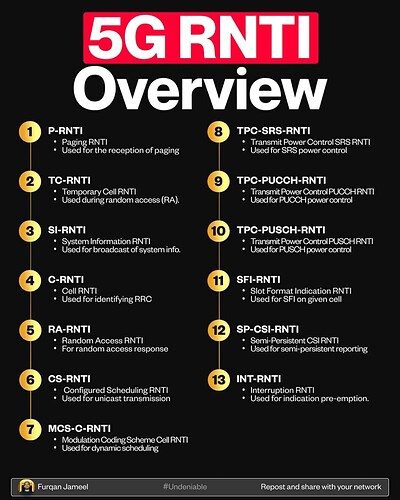Before your data moves in 5G, it gets labeled.
That label is often an RNTI.
Radio Network Temporary Identifiers track many things.
They’re not as scary as they sound.
In fact, they help 5G stay organized and efficient.
Here’s a quick, clear breakdown of 13 key RNTIs:
P-RNTI
Used for paging.
It helps your phone wake up when needed.
TC-RNTI
Assigned during random access.
It’s temporary, just like the name.
SI-RNTI
Used for broadcasting system information to everyone.
C-RNTI
Identifies an RRC-connected user. It’s your ID in the cell.
RA-RNTI
Handles random access responses.
CS-RNTI
Used for scheduled unicast transmissions.
MCS-C-RNTI
Supports dynamic scheduling with Modulation Coding Scheme.
TPC-SRS-RNTI
Controls SRS power levels.
TPC-PUCCH-RNTI
Handles power control for uplink control channels.
TPC-PUSCH-RNTI
Same idea—but for uplink shared channels.
SFI-RNTI
Used to indicate slot formats in a cell.
SP-CSI-RNTI
Supports semi-persistent CSI reporting.
INT-RNTI
Used for pre-emption—interrupts with purpose.
You don’t need to memorize them all.
But knowing what they do clarifies how 5G really works.
Thanks for reading.
LinkedIn: ![]()
